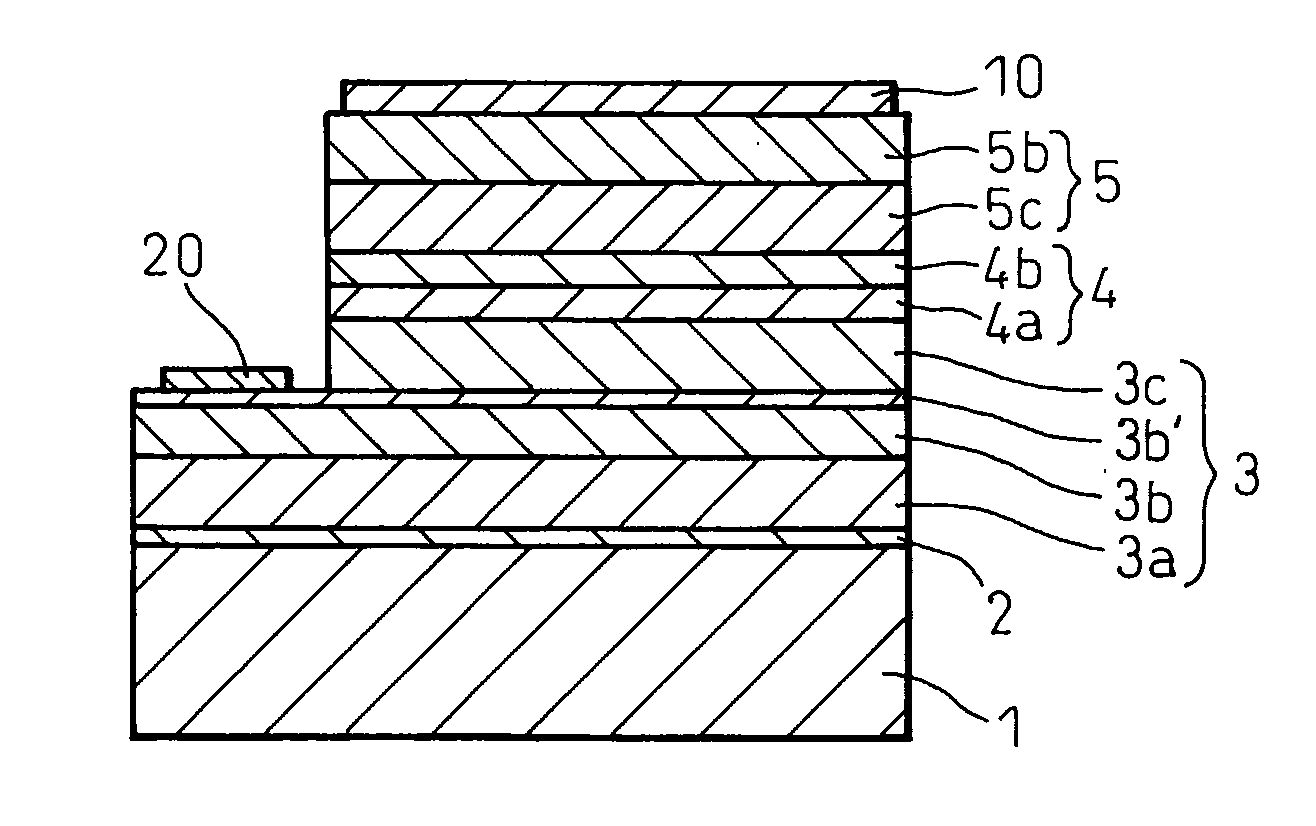Production Method of Group III Nitride Semiconductor Element
a production method and semiconductor technology, applied in semiconductor devices, semiconductor lasers, lasers, etc., can solve the problems of difficult growth of nitride single crystals, failure of epitaxial films to exhibit good crystallinity, etc., to reduce the amount of iii group raw materials, increase the growth temperature excessively, and reduce the growth rate
- Summary
- Abstract
- Description
- Claims
- Application Information
AI Technical Summary
Benefits of technology
Problems solved by technology
Method used
Image
Examples
example 1
[0059]FIG. 2 is a schematic diagram showing the cross-sectional structure of the Group III nitride semiconductor light-emitting device fabricated in this example.
[0060]A stacked structure including a sapphire substrate 1 and Group III nitride semiconductor layers successively stacked on the substrate 1 was formed by means of conventional low-pressure MOCVD through the following procedure. Firstly, a (0001)-sapphire substrate 1 was placed on a high-purity graphite (for semiconductor) susceptor to be heated at a film formation temperature by a high-frequency (RF) induction heater. The sapphire substrate placed on the susceptor was placed in a stainless steel-made vapor-phase epitaxy reactor, and the reactor was purged with nitrogen.
[0061]After passage of nitrogen in the vapor-phase epitaxy reactor for 8 minutes, the substrate 1 was heated over 10 minutes from room temperature to 600° C. by means of the induction heater. While the substrate 1 was maintained at 600° C., hydrogen gas and...
example 2
[0076]A light-emitting device of a Group III nitride semiconductor was formed in a similar way to Example 1, except that, after the n-type contact layer 3b was grown, supplying of TMG and (CH3)4Ge into a vapor-phase epitaxy reactor was completely stopped, without changing the growth temperature, the flow rate of a carrier gas and the flow rate of an ammonia gas. Therefore, there was no reduced-growth-rate layer 3b′ in this example.
[0077]The obtained light-emitting device was evaluated in the same manner as in Example 1. The chip exhibited forward voltage of 3.5 V at a forward current of 20 mA. The emission peak wavelength of the band of blue light emission at a forward current of 20 mA was found to be 460 nm. The emission intensity of the light emitted from the chip, as determined through a typical integrating sphere, was 5 mW. Thus, a Group III nitride semiconductor light-emitting device attaining a high emission intensity was successfully fabricated. In the electrostatic discharge...
example 3
[0078]A Group III nitride semiconductor light-emitting device was formed in a similar way to example 2, except that after an n-type contact layer was grown to half of the total thickness, i.e., after 50 cycles, each cycle consisting of supply of tetramethyl germanium ((CH3)4Ge) for 18 seconds and interruption of supply for 18 seconds, were repeatedly conducted, supplying of TMG and ((CH3)4Ge) into a vapor-phase epitaxy reactor was completely stopped for 30 minutes, without changing the growth temperature, the flow rate of a carrier gas and the flow rate of an ammonia gas. Namely, in this example, growth of a semiconductor layer was interrupted twice, during growth and immediately after growth of the n-type contact layer 3b.
[0079]The obtained light-emitting device was evaluated in the same manner as in Example 1. The chip exhibited forward voltage of 3.5 V at a forward current of 20 mA. The emission peak wavelength of the band of blue light emission at a forward current of 20 mA was...
PUM
| Property | Measurement | Unit |
|---|---|---|
| thickness | aaaaa | aaaaa |
| temperature | aaaaa | aaaaa |
| temperature | aaaaa | aaaaa |
Abstract
Description
Claims
Application Information
 Login to View More
Login to View More - R&D
- Intellectual Property
- Life Sciences
- Materials
- Tech Scout
- Unparalleled Data Quality
- Higher Quality Content
- 60% Fewer Hallucinations
Browse by: Latest US Patents, China's latest patents, Technical Efficacy Thesaurus, Application Domain, Technology Topic, Popular Technical Reports.
© 2025 PatSnap. All rights reserved.Legal|Privacy policy|Modern Slavery Act Transparency Statement|Sitemap|About US| Contact US: help@patsnap.com


